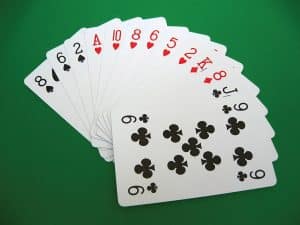For centuries people have got together around campfires, dining room tables, on ships and in pubs to play friendly, and sometimes not so friendly, games of cards.

With families and regions often having their own set of rules passed on from generation to generation, it is easy to see why card games have been and are still so popular.
Playing cards are portable, can be set up quickly, can be played just as easily for a few minutes or few hours and most games can be speedily scaled up or down according to the level of the players.
Generally believed to have been invented in China around the 9th century AD and evolved alongside tile games like dominoes and
mahjong, playing cards gradually moved west with the French simplifying the design and packs in the 1400’s into the 52-card deck and four suits we recognise today.
A few of the most popular card games:
Rummy
One of the best known and widely played card games with many variations and simplifications of rules is Rummy.
Usually played with a 52-card deck with the object to form sets of three or four cards of the same rank or sequences of three or more cards of the same suit by drawing cards from a stockpile and discarding unwanted cards to a waste pile.
One of the best known variants of Rummy is Gin Rummy which is a knock-out game with points scored up to 100 when played over several hands.
Whist
The classic game of Whist is one of the oldest and simplest trump based card games. Played widely in the 18th and 19th centuries Whist was derived from the older game Ruff and Honours and replaced the main popular card game Trumps of the time.
Whist is a partner game, with players partnering the person sitting across from them. The objective is to take more tricks than your opponents. A wide variety of games based on the classic whist have evolved such as Knockout Whist or Solo Whist.
Eventually displaced nowadays by Bridge among serious card players, Whist still remains a popular card game with local ‘Whist Drive’ tournaments.
Blackjack or 21
Believed to be played sometime in the mid or late 1500’s, the card game 21 (or vingt-et-un) was highly popular in Europe. Making its way across the pond the US took the game and changed it into the Blackjack played today.
The goal of Blackjack is simple. The dealer gives each player, including himself, two cards. An Ace can be worth either 1, or 11.
The numbers 2-10 are worth their number value, and face cards are all worth 10. The player can ask to be “hit” and the dealer will deal another card. The goals is to get to 21, or as close to it as possible, without going over. Getting closer than the dealer means a player wins.
Cribbage or Crib
Cribbage with its possible origins in the 16th Century card game called ‘noddy’ was made popular by Sir John Suckling who modified the game and so became cribbage in the 17th century. Cribbage is most often played with two players but can be played with up to four.
The aim is to be the first player to score 121 points with certain groupings of cards. Points are scored on a distinctive pegging out scoreboard called Crib Board.
With all its many variations and regional names given to points Cribbage remains a very popular game with the 4-player version often played in pubs.
Spades
One of the many descendants of Whist, Spades is a classic card game developed in the 1930’s. While in Whist the goal was simply to take the most tricks, in Spades players bid the number of tricks they think they can take and try to take more. The trump doesn’t change and remains always Spades.
Spades is a versatile game with many different versions so enabling it to endure in popularity today.
Hearts or Black Lady
Another trick taking card game, Hearts, has gained in popularity today thanks to Microsoft including it within their computer software.
The game was developed as a variation on the Whist and shares similarities to both Whist and Spades. In Hearts, or Black Lady, the goal is to avoid taking certain cards in tricks, or in many cases, just to avoid taking tricks all together.
Canasta
Canasta is part of the Rummy family of card games and was invented by Segundo Santos and Alberto Serrato in Montevideo, Uruguay, in 1939.
As with Rummy, players build hands of matching cards or suited runes with different card types having different values. Canasta is hugely popular with many national variations.
Poker
An ancient card game which has gained in popularity through the centuries. Poker is a competitive gambling card game with the goal to beat your opponents with a better hand and winning money by either holding a better hand or by bluffing your opponents into believing you hold one.
There have been many variations of the game throughout history and it is as popular today as it ever has been.
Bridge (or Contract Bridge)
Originally known as Russian Whist, Bridge was probably the most popular trick taking card game during the mid-20th Century. Possibly taking its name from the English pronunciation of the Russian ‘Biritch’ is the most popular derivation of Whist. The game has four phases: dealing, bidding, playing, scoring. The goal is to take tricks and fulfil your contract.
Recognised as a mind sport, Bridge is one of the most popular leisure activities in Britain with around 300,000 people playing on a regular basis.
(Article source: Silver Surfers)

